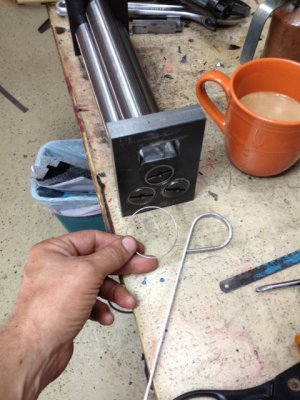- Joined
- Nov 16, 2012
- Messages
- 5,596
Great discussion...
Indeed, I never planned to have a vertical oven and instead, the internal rack was made very strong, "perfectly" level and out of 308 SS which has really good resilience to repeated heat cycles. I acknowledge that most big industrial ovens are vertical.
A big contributing factor in one of the parts being bowed, is likely due to using hot-rolled stock without normalizing or stress relieving prior to machining. I've also learned that, in addition to using stress-relieved stock, keeping the parts cool/cold during the machining process will ultimately yield nearly distortion-free parts once heat treated. In this case, no coolant could be used but, with KoolMist and normal carbide cutting -even heavy cutting, parts never gets above room temperature and in most cases, are actually cold due to the evaporation process. In times past, I've machined parts, heat treated them and had miniscule amounts of distortion.
Another thought I had is the part bowed when I lifted it off the rack using the stainless safety wire. It's common for parts to stick a little and one particular shaft was no exception. I had to give the wire a good tug to break it's adhesion. I might actually have caused the problem at that time but, since they're identical, I have no idea which one put up a fuss. The other two lifted off easily. I could have avoided the whole problem by lifting the entire rack and dunking it. Well... This is just too hard to do safely given the tight quarters and furthermore, my storage and dunk tanks are 10 gallons and too shallow to dunk the whole rack in.
These parts were laid in horizontally and were submerged and rested atop a heavy piece of perforated sheet wire in a heartbeat. Once again, the quenching solution worked great. No boiling and just a tiny amount of fine "soda bubbles" being generated. -Was really happy about that...
My biggest learning experience here... I should have hardened the shafts first -and then cut them down to size using ceramic inserts. -That's likely the whole reason for using ceramic inserts in the first place. I was still thinking "old-school" process while having at hand, new technology tools...
EDIT: BTW, I acknowledge that dunking in the quench vertically is probably a better way to go. The instant a part hits that cold solution, it starts to contract. Dunking vertically would mitigate a horizontal bowing effect for sure. In the case of these parts, my only way to address that was to literally drop the parts in the tank -which I did but for all I know, it wasn't the cure.
Ray
Indeed, I never planned to have a vertical oven and instead, the internal rack was made very strong, "perfectly" level and out of 308 SS which has really good resilience to repeated heat cycles. I acknowledge that most big industrial ovens are vertical.
A big contributing factor in one of the parts being bowed, is likely due to using hot-rolled stock without normalizing or stress relieving prior to machining. I've also learned that, in addition to using stress-relieved stock, keeping the parts cool/cold during the machining process will ultimately yield nearly distortion-free parts once heat treated. In this case, no coolant could be used but, with KoolMist and normal carbide cutting -even heavy cutting, parts never gets above room temperature and in most cases, are actually cold due to the evaporation process. In times past, I've machined parts, heat treated them and had miniscule amounts of distortion.
Another thought I had is the part bowed when I lifted it off the rack using the stainless safety wire. It's common for parts to stick a little and one particular shaft was no exception. I had to give the wire a good tug to break it's adhesion. I might actually have caused the problem at that time but, since they're identical, I have no idea which one put up a fuss. The other two lifted off easily. I could have avoided the whole problem by lifting the entire rack and dunking it. Well... This is just too hard to do safely given the tight quarters and furthermore, my storage and dunk tanks are 10 gallons and too shallow to dunk the whole rack in.
These parts were laid in horizontally and were submerged and rested atop a heavy piece of perforated sheet wire in a heartbeat. Once again, the quenching solution worked great. No boiling and just a tiny amount of fine "soda bubbles" being generated. -Was really happy about that...
My biggest learning experience here... I should have hardened the shafts first -and then cut them down to size using ceramic inserts. -That's likely the whole reason for using ceramic inserts in the first place. I was still thinking "old-school" process while having at hand, new technology tools...
EDIT: BTW, I acknowledge that dunking in the quench vertically is probably a better way to go. The instant a part hits that cold solution, it starts to contract. Dunking vertically would mitigate a horizontal bowing effect for sure. In the case of these parts, my only way to address that was to literally drop the parts in the tank -which I did but for all I know, it wasn't the cure.
Ray
Last edited:



